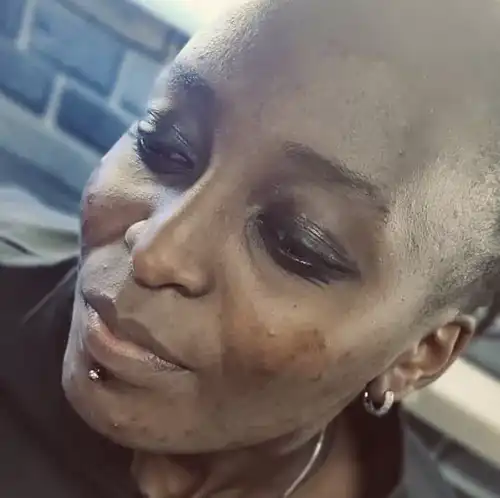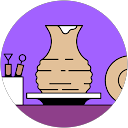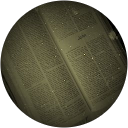Labret Piercing in Nairobi, Kenya
A labret piercing is a type of body piercing located below the bottom lip and above the chin, centered on the face. The term “labret” refers to the placement rather than the jewelry itself. This piercing is versatile and can be styled in various ways, making it popular among people looking for subtle or bold facial adornments.
Variations of the Labret Piercing
Features of a Labret Piercing:
- Location: Just below the bottom lip, in the middle of the face.
- Jewelry: Commonly uses a labret stud, which has a flat back that rests inside the mouth and a decorative piece or ball on the outside.
- Popularity: Worn by people of all genders and is known for its clean and balanced aesthetic.
Labret Piercing Variations
Labret piercings have several variations that allow for creative expression and unique styles. Here’s a breakdown of the most popular types:
- Standard Labret Piercing
– Location: Centered just below the bottom lip.
– Jewelry: Typically a labret stud with a flat back and a decorative top.
– Aesthetic: Minimalistic and symmetrical. - Vertical Labret Piercing
– Location: Runs vertically through the bottom lip, with the jewelry exiting at the lip’s surface and underneath the bottom lip.
– Jewelry: Usually a curved barbell.
– Aesthetic: Gives a sleek and edgy appearance. - Side Labret Piercing
– Location: Placed off-center on either side of the bottom lip.
– Jewelry: Labret stud or small hoop.
– Aesthetic: Asymmetrical, great for those who want something subtle yet unique. - Snake Bites
– Location: Two side labret piercings on both sides of the bottom lip.
– Jewelry: Labret studs or rings.
– Aesthetic: Mimics the look of fangs, creating a bold and striking appearance. - Spider Bites
– Location: Two closely placed piercings on one side of the bottom lip.
– Jewelry: Small studs or hoops.
– Aesthetic: Edgy and clustered, resembling a spider’s bite. - Dolphin Bites
– Location: Two closely placed piercings just below the center of the bottom lip.
– Jewelry: Labret studs.
– Aesthetic: Similar to snake bites but centered for a more balanced look. - Cyber Bites
– Location: Combines a medusa piercing (above the upper lip, below the nose) with a standard labret piercing.
– Jewelry: Labret studs for both piercings.
– Aesthetic: Creates a vertical symmetry for a bold statement. - Angel Bites
– Location: Two piercings on either side of the upper lip, often paired with a standard labret for a unique combination.
– Jewelry: Labret studs or small hoops.
– Aesthetic: Dramatic and eye-catching.
Considerations before getting a Labret Piercing
Before getting a labret piercing, there are several important considerations to keep in mind. Here are some factors to think about before you decide to go through with the piercing:
- Pain Tolerance: Consider your pain tolerance level, as getting a labret piercing involves some discomfort. While the pain is generally tolerable for most people, it can vary from person to person.
- Placement: Decide on the exact placement of your labret piercing. The traditional placement is centered below the lower lip, but there are variations, such as off-center or vertical labret piercings. Think about which placement suits your style and comfort.
- Professional Piercer: Research and choose a reputable and experienced professional piercer who follows strict hygiene and safety protocols. Look for reviews and recommendations to ensure you’re in capable hands. At Rebel Inks Tattoo Removal and Piercings Parlour we have extensive experience and experienced team that is geared to offer you the best services Contact Us Today for further consultation and scheduling
- Jewelry: Consider the type of jewelry you want for your labret piercing. Labret studs with flat backplates and decorative ends are the most common choice. Think about the material, size, and style of the jewelry you prefer.
- Healing Time: Understand that labret piercings require a healing period, usually around 6 to 8 weeks for initial healing and several months for full healing. Be prepared for the commitment required for aftercare during this time.
- Aftercare: Be ready to follow aftercare instructions diligently, which typically involve cleaning the piercing with a saline solution, avoiding touching it with dirty hands, and maintaining good oral hygiene.
- Oral Health: Labret piercings are located in the mouth area, so good oral hygiene is crucial. You may need to use an alcohol-free or saline mouthwash regularly to keep the inside of the piercing clean.
- Swelling: Expect some swelling after the piercing. Be prepared to manage it with over-the-counter pain relievers and ice packs as recommended by your piercer.
- Lifestyle Considerations: Think about how the piercing may affect your daily life, including eating, speaking, and any activities that involve your mouth. You may need to make some adjustments during the healing process.
- Work or School Policies: Consider any policies at your workplace or school regarding visible piercings. Some institutions may have dress code requirements that could affect your choice of jewelry or placement.
- Commitment: Understand that removing the jewelry too soon can lead to complications, so be committed to leaving the jewelry in place until the piercing has fully healed.
- Potential Risks: Be aware of potential risks associated with piercings, including infection, migration, and scarring. It’s important to choose a reputable piercer and follow proper aftercare to minimize these risks.
- Allergies and Sensitivities: If you have known allergies or sensitivities to certain metals, inform your piercer to ensure they use hypoallergenic jewelry materials.
Labret Piercing Procedure
The labret piercing procedure should be performed by a professional piercer in a clean and sterile environment. Here are the general steps involved in the labret piercing procedure:
- Consultation: Before the actual piercing, you’ll have a consultation with our piercer. During this discussion, you can ask any questions you have, discuss your preferences for jewelry and placement, and address any concerns. Your piercer will assess whether you are a suitable candidate for the labret piercing.
- Sterilization: Our piercer will clean and sterilize their hands and the equipment used for the piercing to minimize the risk of infection. They’ll do so wearing gloves and using sterile, single-use needles and jewelry.
- Marking: With a sterile surgical marker, our piercer will mark the precise location where the labret piercing will be placed. This is done while you are sitting up so you can see and approve the placement. You can work with our piercer to determine the exact placement that you prefer.
- Piercing: Once you are comfortable with the placement, our piercer will use a sterilized needle to create the piercing. Some of our piercers may use a receiving tube inside the mouth to guide the needle and jewelry, while others may use a clamp to hold the area steady.
- Inserting Jewelry: After the piercing is made, our piercer will insert the chosen jewelry, which is typically a labret stud. The stud consists of a flat backplate on the inside of your mouth and a decorative end on the outside. The ends can vary in design, such as beads, gems, or other decorative elements.
- Cleaning and Aftercare: Our piercer will provide instructions on how to clean and care for your labret piercing. This usually involves using a saline solution to clean the area and avoiding touching the piercing with dirty hands. Proper aftercare is essential for preventing infections and promoting healing.
- Payment and Aftercare Products: You’ll likely need to pay for the piercing and any aftercare products recommended by your piercer, such as saline solution or healing cream.
- Follow-Up: It’s important to follow up with our piercer as scheduled to check on the healing progress and address any concerns.
- Healing Time: Labret piercings typically take around 6 to 8 weeks for initial healing, but full healing can take several months. During this time, you’ll need to be patient and maintain good aftercare practices.
- Changing Jewelry: It’s generally recommended to wait until the piercing has fully healed before changing the jewelry. Consult our piercer for guidance on changing jewelry and selecting appropriate sizes and styles.

Labret Piercing FAQ’s
Pain and Healing of Labret Piercing
Pain Level of a Labret Piercing
The pain experienced during a labret piercing is typically moderate and brief, as the lower lip area is fleshy and easy to pierce. Here’s what to expect:
- Procedure Pain
– The initial piercing feels like a sharp pinch or pressure.
– Pain intensity: 3-4/10 for most people. - Post-Procedure Pain
– Swelling, soreness, and slight discomfort are common for the first few days.
– Pain decreases significantly after the swelling subsides.
Factors Affecting Pain
- Your pain tolerance.
- The piercer’s skill and technique.
- Jewelry material and size.
Healing Time of a Labret Piercing
- Initial Healing: 6-8 weeks
– Swelling and tenderness reduce in the first 1-2 weeks.
– The piercing begins to close around the jewelry. - Full Healing: 3-6 months
– The inner tissue takes longer to heal completely.
– Healing may extend if proper aftercare isn’t followed or due to irritation.
Signs of a Problem
If you notice any of these, consult your piercer or a medical professional:
- Prolonged swelling or redness.
- Pus or foul-smelling discharge.
- Severe pain that doesn’t improve after the first week.
Labret Piercing Aftercare Guide
Proper aftercare is crucial to ensure your labret piercing heals quickly and safely while preventing infection or complications. Here’s a detailed guide:
Daily Cleaning Routine
- Clean Twice Daily:
– Use a sterile saline solution or a piercing-safe aftercare spray.
– Gently clean the area around the jewelry with a cotton swab or pad. Avoid harsh scrubbing. - Oral Rinse: Rinse your mouth with an alcohol-free antiseptic or saline solution after eating or drinking anything other than water.
Lifestyle Adjustments
- Avoid Touching the Piercing
– Only touch the piercing with clean, washed hands.
– Avoid playing with or twisting the jewelry to prevent irritation. - Modify Your Diet
– Stick to soft, bland foods for the first few days (e.g., yogurt, soups).
– Avoid spicy, acidic, or crunchy foods that can irritate the piercing. - Stay Hydrated
– Drink plenty of water to aid healing.
– Avoid alcohol and smoking during the healing period as they delay recovery.
Jewelry and Piercing Care
- Don’t Change the Jewelry Prematurely: Wait until the piercing is fully healed (6-12 weeks) before swapping out the jewelry.
- Check for Tightness: Ensure the jewelry is secure but not overly tight. Your piercer can check this for you during a follow-up visit.
- Choose Hypoallergenic Materials: Stick to high-quality metals like titanium, surgical steel, or gold to reduce the risk of irritation or allergic reactions.
What to Avoid
- Oral Habits: Refrain from chewing on pens, straws, or nails.
- Makeup and Skincare: Avoid applying lip products or creams near the piercing.
- Swimming: Stay out of pools, hot tubs, and natural water bodies for at least a month.
Signs of Healing vs. Infection
- Healing: Mild swelling, slight redness, or crust around the jewelry are normal.
- Infection: Watch for prolonged swelling, pus, severe pain, or fever. If these occur, consult a piercer or doctor immediately.
Labret Piercing Jewelry Options
The jewelry for a labret piercing is specially designed for comfort, functionality, and style. Here’s a guide to the types of jewelry, materials, and sizes suitable for this piercing:
Types of Labret Piercing Jewelry
- Labret Stud
– Design: Features a flat backplate that sits inside the mouth and a decorative top on the outside.
– Advantages: Comfortable, minimizes gum and tooth irritation.
– Top Styles: Plain ball, gem-studded, flat disks, or decorative shapes (stars, hearts). - Flat-Back Barbell
– Design: Similar to a labret stud but with threading for interchangeable tops.
– Advantages: Versatile and easy to customize. - Circular Barbell (Horseshoe)
– Design: A semi-circular ring with beads or decorative ends.
– Advantages: Gives a bold and edgy look. - Captive Bead Ring (CBR)
– Design: A circular ring with a captive bead that holds the jewelry in place.
– Advantages: Provides a more prominent appearance. - Hoops
– Design: Thin, seamless rings or clicker hoops that wrap around the piercing.
– Advantages: Lightweight and minimalist.
Materials for Labret Jewelry
- Titanium: Hypoallergenic, lightweight, and durable. Ideal for sensitive skin.
- Surgical Stainless Steel: Affordable and resistant to corrosion. Not suitable for those with metal allergies.
- Gold (14K or 18K): Luxurious and hypoallergenic. Avoid gold-plated jewelry for healing piercings.
- Bioplast or PTFE: Flexible and biocompatible. Perfect for minimizing gum and tooth damage.
- Niobium: Hypoallergenic and softer than steel, making it a great alternative for healing piercings.
Sizing Guide
- Gauge (Thickness): 16G (1.2mm) or 14G (1.6mm).
- Length:
– Initial Jewelry: 8mm to 12mm, depending on swelling.
– Healed Piercing: Shorter lengths, like 6mm to 8mm, for a snug fit.
Choosing the Right Jewelry
- For new piercings, opt for simple labret studs made from titanium or PTFE to allow for swelling.
- For healed piercings, experiment with decorative tops, hoops, or barbells.
Cost of a Labret Piercing in Nairobi, Kenya
The cost of a labret piercing depends on various factors such as the studio’s location, the piercer’s experience, and the jewelry chosen. Here’s a general breakdown:
Average Cost
- Standard Pricing:
– Ksh. 1,500 to Ksh. 2,000 for the piercing procedure alone (excluding jewelry).
– Prices may be higher in premium studios or for highly experienced piercers. - Jewelry Cost:
– Basic Jewelry (Titanium or Surgical Steel): Ksh. 300 to Ksh. 800
– Premium Jewelry (Gold or Gem-Studded): Ksh. 1,000 to Ksh. 1500
Factors Influencing Cost
- Studio Location: Urban areas or upscale neighborhoods often charge more due to higher demand and overhead costs. Rebel Inks Tattoos, Tattoo Removal, and Body Piercings Parlour is located in the heart of the Central Business Disrict (CBD) in Nairobi, Kenya, and is easily accessible to both locals and foreigners in the country.
- Piercer Experience: Piercers with extensive experience and certifications typically charge more for their expertise. At Rebel Inks Tattoos, Tattoo Removal, and Body Piercings Parlour we have experienced professionals who offer quality and premium services.
- Jewelry Material and Design: Hypoallergenic materials like titanium or gold are pricier but safer for healing.
- Aftercare Products: At Rebel Inks Tattoos, Tattoo Removal, and Body Piercings Parlour offer saline solutions or aftercare kits for an additional Ksh. 500 to Ksh. 1,000
Additional Costs to Consider
- Follow-Up Appointments: Some studios include a free check-up, while others may charge a small fee (Ksk. 500 – Ksh. 1,000).
- Jewelry Upgrades: Post-healing, upgrading to decorative or premium jewelry can add to the overall cost.
Pro Tips for Cost Efficiency
- Research and compare prices at reputable studios in your area.
- Ensure the studio adheres to strict hygiene and safety standards; don’t compromise quality for a lower price.
- Ask if aftercare products are included in the piercing package.
Possible Side Effects of a Labret Piercing
While a labret piercing can be a stylish and safe choice, it’s important to be aware of potential side effects, especially during healing. Most issues can be avoided with proper aftercare.
Initial Side Effects
These are normal during the healing process and typically resolve within a few days to weeks:
- Swelling: Mild swelling around the piercing site.
- Redness and Tenderness: Common as the body responds to the new piercing.
- Bruising: May occur due to the piercing needle.
Long-Term or Severe Side Effects
- Infection
– Symptoms: Persistent redness, warmth, pain, swelling, pus discharge, or fever.
– Prevention: Clean the piercing regularly with saline solution and avoid touching it with dirty hands. - Gum Recession
– Cause: Jewelry rubbing against the gums over time.
– Prevention: Use flat-back labret studs or bioplast jewelry to minimize friction. - Tooth Damage
– Cause: Jewelry coming into contact with teeth, causing chipping or erosion.
– Prevention: Opt for small, snug jewelry and avoid biting down on it. - Keloids or Hypertrophic Scars
– Cause: Excessive scar tissue growth at the piercing site.
– Prevention: Avoid trauma to the piercing and consult a piercer if you notice unusual bumps. - Allergic Reactions
– Cause: Sensitivity to jewelry materials (e.g., nickel).
– Prevention: Use hypoallergenic materials like titanium, surgical steel, or gold. - Migration or Rejection
– Cause: The body pushes the jewelry out over time, often due to improper placement or unsuitable jewelry.
– Prevention: Have the piercing done by an experienced piercer and choose high-quality jewelry. - Prolonged Healing or Irritation
– Cause: Poor aftercare, frequent touching, or exposure to irritants like makeup or harsh chemicals.
– Prevention: Follow aftercare instructions diligently and avoid irritating the piercing.
When to Seek Help
- Signs of infection, such as excessive pain, pus, or fever.
- Jewelry embedding into the skin.
- Severe swelling that obstructs breathing or eating.
Pro Tips
- Always get pierced by a professional in a clean, reputable studio.
- Stick to the recommended jewelry size and material during healing.
- Keep a close eye on your piercing and address issues early.
Related Piercing
Get In Touch
For more information on the list above and any other special services,please call or come in for free consultation
Testimonials
The piercing wasn't as painful as I had thought and the process was quick and satisfactory. I love it!!!
The piercing is healing well thanks to the aftercare instructions and follow-up. I would highly recommend Rebel Inks
Eric also did a belly button piercing for a friend, guiding her through the process, doing the piercing and then explaining the after care to her.
The shop is on the 3rd floor, with the entrance to the stairs near an alleyway on the left. The shop is perfect size, clean, and attractive looking. The mural is pretty dope.
Thank you for the amazing service! 🔥👅✨
I got piercibgs there and the process was really good. My biggest concern was hygiene but that wasn't an issue at all, they use new needles and they sanitize them.
The service itself was also welcoming.
I was informes of everything i needed to know beforehand.
10/10 would recommend!
Eric was so calm and patient with my almost 2 year old lady. It was such a clean and hygienic process. We will definitely be back for our second rounds of piercings and maybe even another tattoo!
They assess the area before any art and advise one accordingly. They also give one post clean up process and also do a check up after the body art projects. Overall, I loved my experience and I’m hooked. 👍
Will definitely come back next time I’m in town 🙂
He listened to what I actually wanted and made sure he could fit in the time before I flew back home.
The shop is clean & private and is easy enough to find.
Eric has even checked in a couple of times since to make sure all is good.
I would totally recommend Eric! I absolutely love my Elephants!
I had a very easy healing period and always follow up from Eric to check on my progress...I would highly recommend if you are a first timer because from my experience all went very well and attention to detail
Thank you for a good job and looking forward to send all my friends your way
And all the best with the new year 2025!
From the moment I walked in, the staff was super friendly and made me feel at ease. The studio had a clean, professional atmosphere, which immediately put me at ease. My piercer was incredibly skilled and explained every step of the process, ensuring I was comfortable the entire time. The piercing was quick and practically painless, and the aftercare instructions were clear and easy to follow. I can tell they really care about the health and safety of their clients.
Overall, a fantastic experience—I highly recommend Rebel Inks and Tattoos for anyone looking to get pierced or tattooed!
They do follow up after their services
Eric's Studio isn’t just a place to get a tattoo—it’s an experience. The combination of professionalism, artistic talent, and a welcoming environment makes it a standout destination for anyone considering a tattoo.
I highly recommend Eric’s Studio to both first-timers and seasoned tattoo enthusiasts. If you’re looking for a high-quality tattoo and an enjoyable experience, this is the place to go.
I would definitely recommend their services again and again
Thank you Rebel Ink
My piercings are healing ❤️🩹 well
I would 💯 recommend
I will definitely come back for more .
Two, all the equipments he used for the piercings were new and/or sterilised.
Three, the parlour itself was very clean and was up to par with the hygiene standards.
Four, Eric provided effective aftercare instructions, making sure I knew exactly how to take care of my new piercings and he kept in touch and continues to do so, to check on the healing progress.
I highly highly highly recommend this place!!!
Would definitely recommend them to friends and go back for other piercings
Not only was the piercing process smooth, but he also provided thorough aftercare instructions, making sure I knew exactly how to take care of my new piercings. What really impressed me was that he keeps in touch to check on how the healing is progressing – a sign of true care for his clients.
The shop maintains a high standard of hygiene, and the atmosphere is welcoming and comfortable, which really added to the positive experience. I highly recommend this place to anyone looking for a professional and caring experience. I’ll definitely be coming back for any future piercings!
My appreciation for the excellent customer service I received. The follow-ups were prompt, and I truly appreciated the gentleness and professionalism throughout. Thank you!"
"Looking for professional eyebrow microshading removal? Look no further!"
The customer care is top tier 👌🏾👌🏾.
Wonderful place to get tattoos and piercings. 💯💯
Eric goes ahead to follow up on his clients progress and gives good advice each time I reach out to him.
I would recommend Reble tattoos anytime.
Good job bro we really appreciate.
Ohh and the price is very fair.
The environment was clean , procedure was sterile and the jewelry used are of the best quality.
He followed up with me during the healing process, he educated me on what I needed to do for my aftercare.
Eric is confident, skilled , experienced and the best piercer. Highly recommend Rebel inks.✨
Definitely recommend!
Great experience.
Eric definitely know what he is doing .
I got exactly what I wanted 2 tiny tats on the same finger .
He was kind and patient throughout the session.
Healing process has been good .
Aftercare services were given and regular checkups on the healing process were done.
I would 💯recommend.
Eric gave me the best reception as it was my first time there,and made me trust him all the way. I appreciate good services.
There services are also affordable not to forget 😊.
He was also invested in the aftercare and would ensure I follow the do's and don'ts in taking care of the tattoo and ensuring proper healing and maximum ink retention.
Would highly recommend Rebel Inks Tattoos.
Rebel Inks Tattoo offer the best,affordable and quality tattoo removal services.If you have unwanted ink,choose Rebel Inks Tattoo,they're the best of the best and the professionalism is a top notch.They ensure you're free from unwanted ink with their Laser Tattoo Removal Technology...
I did a Laser Tattoo Removal with them and i can attest they're the best....
Kudos Eric...
I highly recommend.
It was a generally good experience with good hygiene during the piercing process and has been a smooth healing process.... 10/10
tips. Highly recommend 👍🏽
100% recommendable.
I was particularly impressed with Eric's attention to hygiene. He thoroughly cleaned the room before I entered, sanitized all of the equipment he would be using, and changed gloves between each ear. This level of cleanliness gave me great confidence in his professionalism.
Eric's commitment to customer service did not end on the day of the piercing. He followed up with me regularly throughout the healing process to ensure that I was following the aftercare instructions and that my earlobes were healing properly.
I highly recommend Rebel Inks to anyone in Nairobi who is considering getting a piercing. Eric is a highly skilled and experienced piercer who takes great pride in his work.
So I Check all the boxes below and more:
Customer Care: ✔️
Professionalism : ✔️
Cleanliness ✔️
Price: ✔️
After care service ✔️
Thanks and good job, Eric
The place is neat and clean and the equipments he used were also fine standards. Really appreciate his following up with me on the healing 🤗
I WOULD HIGHLY RECOMMEND THEIR SERVICES to everyone. Actually what you see on their website is EXACTLY what you will get. Keep up the good work Rebel inks Tattoos.
The infection is now gone. I would definitely recommend!
Can recommend this place totally and would go back there anytime!
Thanks!
OUR LOCATION
Areas We Serve
NAIROBI
KIAMBU
KAJIADO
MACHAKOS













































































































































































































